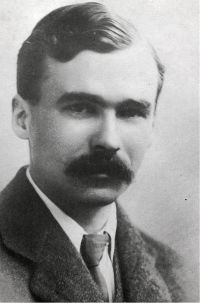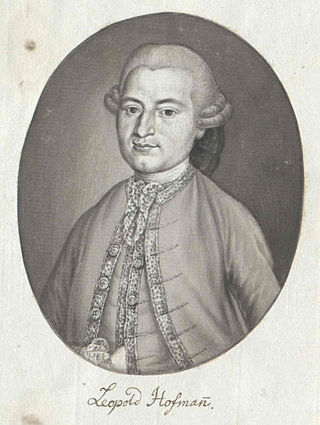Related Research Articles

George Sainton Kaye Butterworth, MC was an English composer who was best known for the orchestral idyll The Banks of Green Willow and his song settings of A. E. Housman's poems from A Shropshire Lad. He was awarded the Military Cross for his gallantry during the fighting at Pozières in the First World War, and died in the Battle of the Somme.

Carl Ditters von Dittersdorf was an Austrian composer, violinist, and silvologist. He was a friend of both Haydn and Mozart. His best-known works include the German Singspiele Doktor und Apotheker and a number of programmatic symphonies based on Ovid's Metamorphoses.

Franz Ignaz Beck was a German violinist, composer, conductor and music teacher who spent the greater part of his life in France, where he became director of the Grand Théâtre de Bordeaux. Possibly the most talented pupil of Johann Stamitz, Beck is an important representative of the second generation of the so-called Mannheim school. His fame rests on his 24 symphonies that are among the most original and striking of the pre-Classical period. He was one of the first composers to introduce the regular use of wind instruments in slow movements and put an increasing emphasis on thematic development. His taut, dramatic style is also remarkable for its employment of bold harmonic progressions, flexible rhythms and highly independent part writing.

Leopold Hofmann was an Austrian composer of classical music.
Mily Balakirev began work on his Symphony No. 2 in D minor in 1900, but did not complete the work until 1908. The premiere of the symphony was conducted by Russian composer Sergei Liapunov, a student of Balakirev, in St. Petersburg in 1909. Another performance was held in Paris soon afterwards.
Benjamin-Gunnar Cohrs was a German conductor, music scholar, and publicist on music.
References
- ↑ Score at the International Music Score Library Project
- ↑ Score at the International Music Score Library Project
- 1 2 3 4 5 "British Symphonies on CD Page 1". MusicWeb International. 2007. Retrieved 23 November 2007.
- ↑ Lace, Ian (July 2002). "Review of Recording of Atterberg Symphonies 2 and 5". MusicWeb International. Retrieved 23 November 2007.
- ↑ Score at the International Music Score Library Project
- ↑ "Johann Christoph Friedrich Bach" in Nolte, Ewald V., ed., Four Early Sinfonias at Google Books. Dates based on early copies by Johann Friedrich Peter. Madison, Wis.: A-R Editions, 1982. Preface page xi. ISBN 0-89579-170-6. OCLC 9203471.
- ↑ Beck, Franz Ignaz; Badley, Allan (1997). "Beck Symphony op. 1 no. 2". Wellington, NZ: Artaria Editions. OCLC 39295085 . Retrieved 19 September 2017.
- ↑ Beck, Franz Ignaz; Badley, Allan (1998). "Beck Symphony op. 3 no. 1". Wellington, NZ: Artaria Editions. OCLC 40564487 . Retrieved 19 September 2017.
- ↑ Beck, Franz Ignaz; Badley, Allan (1999). "Beck Symphony op. 4 no. 4". Wellington, NZ: Artaria Editions. OCLC 43189369 . Retrieved 19 September 2017.
- ↑ "Boccherini Symphony Catalog at U. Quebec" . Retrieved 25 November 2007.
- ↑ Publisher's Catalog, including Boëllmann Symphony (PDF). Paris: Durand-Salabert-Eschig. p. 38. Archived from the original (PDF) on 31 October 2008. Retrieved 24 August 2008.
- ↑ Bekker, Leander Jan de. Stokes' Encyclopedia of Music and Musicians at Google Books, page 86.
- ↑ Cannabich, Christian; Badley, Allan (1997). "Cannabich Sinfonia op. 10 no. 4". Wellington, NZ: Artaria Editions. Archived from the original on 15 February 2012. Retrieved 9 December 2008. ISBN 1-877170-79-8. OCLC 38074922.
- ↑ Chadwick Symphony No. 3 — 2002 Reprint of 1896 Edition of Score at Google Books
- ↑ MARC Record at the Free Library of Philadelphia (catalog.freelibrary.org) for Cowen's 5th Symphony
- ↑ A History of the Royal Philharmonic Society at Google Books. p. 249.
- ↑ "Draeseke Worklist". International Draeseke Society. Retrieved 24 November 2007.; Schlüren, Christoph (2003). "Preface to Score of Draeseke 2nd Symphony (from Notes to cpo Recording of the Same)" (in German and English). Retrieved 29 August 2020.
- ↑ Robinson, Bradford (2005). "Online Publication of Preface to Score of Fibich First Symphony". Musikproduktion Juergen Hoeflich. Retrieved 24 August 2020.
- ↑ "Gouvy Symphony No. 2". University of Michigan Library. Retrieved 7 May 2008.
- 1 2 Wyn-Jones, David (2006). The Symphony in Beethoven's Vienna. Cambridge University Press. ISBN 978-0-521-86261-5 . Retrieved 8 May 2008.
- ↑ Gyrowetz, Adalbert; Dussek, Jan Ladislav (1983). Rice, John A. (ed.). Four Symphonies; One symphonie concertante : them. index 206. The Symphony, 1720–1840, Series B. Vol. 11. New York; London: Routledge. ISBN 978-0-8240-3826-7.
- ↑ Hofmann, Leopold; Badley, Allan (1995). "Hofmann Sinfonia Badley F1". Wellington, NZ: Artaria Editions. OCLC 46912653. Archived from the original on 7 July 2011. Retrieved 8 May 2008..
- ↑ Hofmann, Leopold; Badley, Allan (1995). "Hofmann Sinfonia Badley F2". Wellington, NZ: Artaria Editions. OCLC 40451016. Archived from the original on 7 July 2011. Retrieved 8 May 2008..
- ↑ Lace, Ian (May 1999). "Review of Recording of Huber Fifth Symphony". MusicWeb International. Retrieved 22 November 2007.
- ↑ "Answers.com Karg-Elert Page". Answers.com . Retrieved 9 August 2008.
- ↑ Novello Catalogue of Orchestral Music at Google Books, page 62; "Nachrichten: Vorwort der Redakzion". Allgemeine Musikalische Zeitung (in German). Leipzig: Breitkopf und Härtel: 441–6. June 1839. Retrieved 8 May 2008.. Also see Wulf (1999) as per List of compositions by Franz Lachner.
- ↑ Schlüren, Christoph (2004). "Online Publication of Preface to Score of Martucci Second Symphony" (in German). Musikproduktion Juergen Hoeflich. Retrieved 29 August 2020.
- ↑ Rijen, Onno van. "Opus by Miaskovsky". Archived from the original on 10 December 2007. Retrieved 22 November 2007.
- ↑ Brookes, Phillip (2006). "Online Publication of Preface to Score of Parry Sym. 2". Musikproduktion Juergen Hoeflich. Retrieved 29 August 2020.
- ↑ Pleyel, Ignaz; Smith, Raymond R.; Townsend, Douglas (1981). Four symphonies : one symphonie concertante. New York: Routledge (formerly Garland Publishing). ISBN 978-0-8240-3804-5 . Retrieved 24 September 2013.
- ↑ "Pleyel Pages". The Haydn Project. Archived from the original on 27 September 2007. Retrieved 8 May 2008. (possibly the same as Symphony no. 10 above. Benton number not known for either.)
- ↑ "Prout Symphony 3". University of Michigan Libraries. Retrieved 7 May 2008.
- ↑ "Symphony No. 3 Im Walde". Raff.org. Retrieved 22 November 2007.
- ↑ For 1808 date: Wyn-Jones, p. 105.
- ↑ "Rheinberger Biography". Carus-Verlag. Archived from the original on 27 February 2009. Retrieved 23 November 2007.
- ↑ Barnett, Rob (February 2007). "Review of Recording of Ries' Symphonies". MusicWeb International. Retrieved 22 November 2007.
- ↑ Robinson, Bradford (2004). "Online Publication of Preface to Score of Rubinstein Symphony No. 1". Musikproduktion Juergen Hoeflich. Retrieved 24 August 2020.
- ↑ Teller-Ratner, A Thematic Catalogue, Volume 1, pp.266-68. Autograph manuscript has dates 2 June-25 July 1856.
- ↑ Howell, Christopher (June 2004). "Review of cpo Recording of Sinding's Symphonies 3 and 4". MusicWeb International. Retrieved 7 May 2008.
- ↑ Brookes, Phillip (2005). "Online Publication of Preface to Score of Stanford Symphony 4". Musikproduktion Juergen Hoeflich. Retrieved 29 August 2020.
- ↑ Score available at IMSLP
- ↑ "Musical Notes from Abroad". The Musical Times. 78 (1129). Musical Times Publications: 271–274. March 1937. doi:10.2307/918068. ISSN 0027-4666. JSTOR 918068.
- ↑ OCLC 4619326 has key, opus no., early publication —also 1937— and publisher (Leuckart) for Trapp's 5th symphony.
- ↑ Robinson, Bradford (2005). "Preface to Score of Weingartner's Symphony No. 4". Musikproduktion Juergen Hoeflich. Retrieved 29 August 2020.
- ↑ OCLC 68921369.